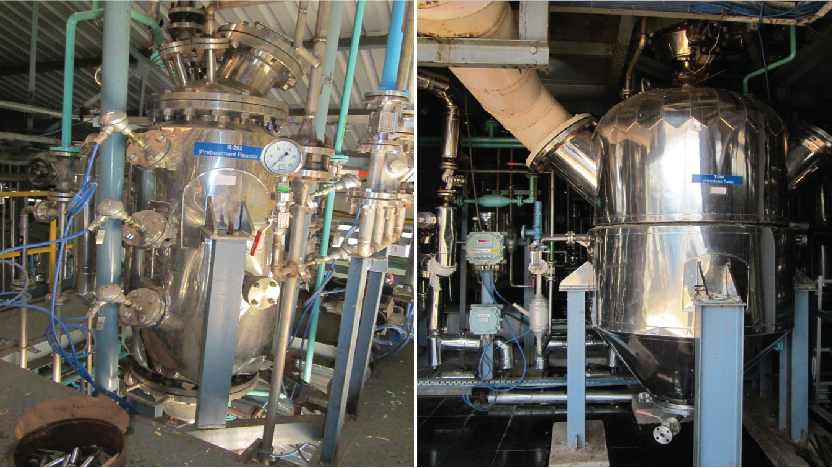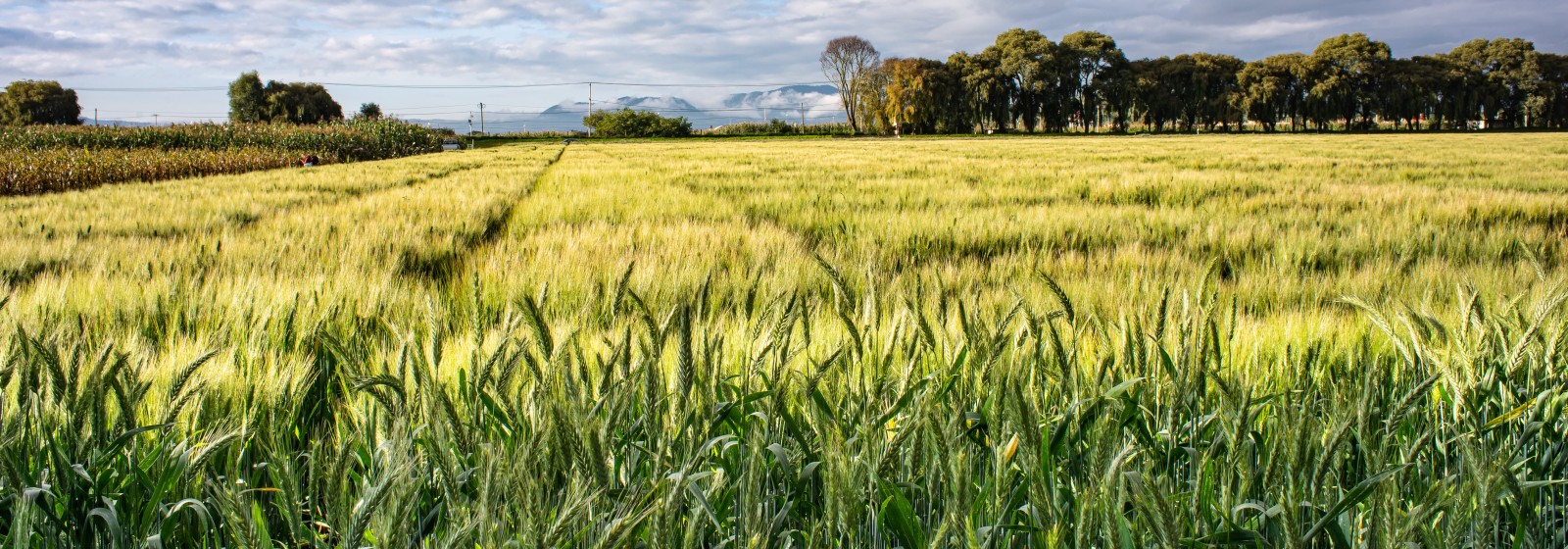Since ancient times, farmers across the developing world have made use of the leftover stems and stalks from cereal crops like rice, wheat, corn and sorghum by feeding them to their animals. The practice makes sense: crop residues are abundant, with about 3.8 billion metric tons being produced annually; they’re free or very cheap to obtain; and access to alternatives like grazing land and supplementary feed is often expensive and out-of-reach for smallholders.
Currently around 70-75% of developing country livestock diets rely on these crop residues. They contain carbohydrates in the form of cellulose and hemicellulose, which–nutritionally speaking–is a good thing. Here’s the catch, however – around 70 percent of these are undigestible because they’re bound together with a substance called lignin, which, in this form, the animals’ gut flora can’t break down.
“It’s kind of like a coconut: you can only access the edible part if you break it open,” says Padmakumar Varijakshapanicker, who is the acting head of ILRI’s Feed Technology Research Platform in Hyderabad, India. “These lignocellulosic bonds are a complex that has to be broken in order for more of the sugars to become available to the animal.”
This inability to access the majority of the nutrients in crop residues limits livestock productivity in developing countries: the majority of animals who feed on crop residues are not producing anywhere near the amount of milk or meat of their developed-world counterparts. Their environmental footprint is also higher – underfed livestock and/or high fibre-based diets can result in the release of similar amounts of – or in some cases even more – methane than healthier, more productive animals.
“The amount of greenhouse gases per unit productivity goes down significantly as you feed animals better,” says Chris Jones, who is the program leader for feed and forage development at the International Livestock Research Institute (ILRI).
On top of this, because crop residues fetch such low prices as feed, “many farmers simply burn them, creating pollution problems and contributing to carbon emissions,” says Seshu Kumar Avadhanam, a scientist at the Indian Institute of Chemical Technology (IICT). “In India alone, about 100 million metric tons are burned every year.”
What, then, if those crop residues could be transformed into something more nutritious? This is the challenge that ILRI scientists set for themselves, together with IICT scientists like Avadhanam: to figure out smart, sustainable, cost-effective ways to tap into the nutritional bounty of crop residues.

Bouncing off biofuel technologies
Fortunately, scientists in rather a different field – biofuel technology – have been exploring that very question for quite some time. Many biofuels are made from ethanol, which is created from fermented sugars. The earliest (‘first-generation’) bioethanols used more-accessible sugars and oils from arable crops such as corn and sugarcane.
However – partly in response to criticism that the production of these fuels was taking up space and resources that could be used to feed people – researchers began developing techniques to extract sugars from lignocellulosic biomass, so they could source fuel (known as 'second-generation' biofuel) from crop residues and biomass grown on marginal land.
Three biomass treatment techniques developed for the first stages of the bioethanol production process include: a two-chemical combination treatment (2CCT) that uses an alkali and an oxidant to treat residues, which are then washed, dried and used; an ammonia fibre expansion treatment (AFEX), a patented US technology whereby ammonia is added to the biomass under moderate pressure and temperature before rapidly releasing the pressure, and; steam explosion, an effective method that treats biomass with hot steam under pressure, that is then decompressed explosively.
While the drastic drop in the price of oil in the past few years has slowed down global interest and investments to upscale biofuel production, this has opened up opportunities for ILRI/IICT researchers to test how these second-generation biofuel technologies could be used to unlock the nutritional value of crop residues. In 2020 they embarked on a pilot project in Hyderabad, India to work out if such a process might be viable.
“Using these different methods to break the lignocellulosic bond for animal nutrition purposes is very expensive,” explains Padmakumar. “That's why people didn't venture into experimenting with this [for crop residues] before. But in the case of bioethanol production, billions and billions of dollars have already been invested. So we wanted to piggyback on whatever investment is already there.
In the labs of IICT, scientists tested out the three processes using various types of straws and stovers, to analyse what happens to their digestibility under each method. Using in vitro methods, they found that digestibility of the treated residues increased by about 8.9% using steam explosion; 19.3% using AFEX; and 38.2% using 2CCT.
The results were heartening, “but a lab environment doesn't always tell the full story,” says Jones. “The real proof of the pudding is in feeding animals and seeing how they respond.”
ILRI researchers then carried out field trials with sheep to see whether the 2CCT and steam-treated feed translated into increased weight gain for the animals (at this point, the AFEX treatment was dropped from the trial because of health concerns about acetamide, a by-product of the process). They prepared ‘complete feeds’ using 71% treated crop residue and 29% other nutrient concentrates (as well as a control version using untreated crop residue), and fed these to groups of sheep over a period of 70 days.
The outcome was remarkable. In the control group, the sheep put on an average of 1.66 kilograms, while in the steam treatment group it was 3.92 kilograms and in the 2CCT, 6.12 kilograms.
“That is a big difference in productivity over a relatively short period of time,” says Padmakumar.
“The experiments really showed the potential for these two objectives – providing a very nutritious feed source for animals, while creating a value-added product out of crop residues and mitigating the need for burning – to be met together,” says Avadhanam.

A financial sticking point
Although there have been significant progress and results thus far, “there are still more tests to be done”, says Padmakumar.
“We can continue the pioneering work, but we need funds to take it further,” he says. “It will be a real game-changer if everything goes in the right direction.”
The scientists want to test out results from different types of crop residue and other waste biomass. They’d also like to trial the treated feed on larger livestock such as cows, and assess changes in milk production.
Another critical step is to establish the economics of such a process, and figure out how to create demand and integrate the feed into existing commercial feed value chains.
“The cost of transporting straw and stover is expensive because they're bulky,” says Jones. “So trying to find that balance where you're getting local supply to a plant which can process the biomass and then feed it out to the animals is critical to the economic success.”
That includes working out how centralized or decentralized the processing might be: “do we have a single big plant where everybody brings their straw and processes it through it, or is it better for this to be on the village basis, with some entrepreneur in each local village processing the straw and stover that come through their farmers?” asks Jones. “All of these things we still need to know.”
Herein lies the crux. To properly answer these questions, the scientists need a pilot plant that can produce a lot more feed on a shorter timescale than what was possible at the IICT lab. To repurpose a disused biofuel plant for the cause, however, is rather costly – around 50 million INR (USD 750,000). This will likely require government or external funding at the outset, says Avadhanam.
“This work is addressing a societal problem, so governmental support makes sense,” he explains. “From there, private agencies are more likely to come on board once we have developed a pilot scheme and demonstrated the technology to them.” There are already signs of interest from private feed companies.
“The demand for meat and milk is going up,” says Jones. “So we need to increase productivity and efficiency, while reducing greenhouse gas emissions. This is an opportunity across Africa, Asia and South America – anywhere where there are a lot of crop residues that are currently burned and there’s a deficit in animal feed. It’s got global potential.”
The developments align well with wider efforts to improve the feed quality of crop residues, which stretch back to the beginning of the 20th century. ILRI, for its part, is involved in ongoing collaboration with plant breeders in other research centres to support the selection of livestock feed traits alongside those for grain production and quality. The added value of improved crop residues is becoming increasingly well-recognized amongst farmers across the developing world.
--
The ILRI community gratefully acknowledges Michael Blümmel, a distinguished former scientist in ILRI’s feed and forage development program, who passed away in 2020, for his leadership in the development of this area of research over many years. None of the advances cited here would have been possible without his drive and exceptional commitment to employing highest-quality science to find real-world solutions for the world’s neglected small-scale livestock keepers.
Learn more
- Spin-off technologies from 2nd generation biofuel: Potential to transform fodder quality of crop residues
- Leverage spin-off effect from 2nd generation biofuels to turning Indian cereal straws and stover into concentrate feeds
- Ammonia Fiber Expansion (AFEX) as spin off technology from 2nd generation biofuel for upgrading cereal straws and stovers for livestock feed
- Looking for opportunities from second generation bio-fuel technologies to upgrade lignocellulosic biomass for livestock feed
